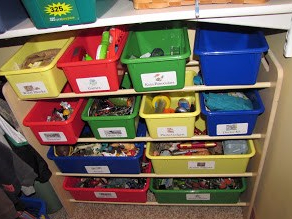
Toy rotation systems promote higher-level thinking during play and result in children playing for increased increments of time.
Step 1 – Collect all the Toys
Find every toy in your home that is a good candidate for toy rotation and toss it into a pile. However, consider leaving your pretend-play food in the kids kitchen or the elaborate puzzles in their boxes OR can choose to place them in zip-lock pouches. This is the best time to purge or declutter.
Step 2 – Sort (The toughest part)
Sort your toy pile into several smaller piles according to the toy’s primary educational functions listed below. It sounds worse than it is!
A primary educational function can be mathematics, Language, Science, Arts, Drama, Cutting & Gluing, Puzzles, Building (blocks etc), manipulatives, practical life, music, logic, social studies, Worldwide, imaginative play and so on. [If you are a SUPER SUPER SUPERMOM]
Or
{WHAT I SUGGEST STRONGLY – PRACTICAL MOM }
You can categorise into bulk items by their end outcome
Moving toys like cars,balls
Pretend play toys like cash registers, kitchen sets, farms, car-washing station, etc.
Thinking toys like puzzles and board games
Developmental toys like sensorial, sorting, fine motor, gross motor, etc.
Exhausting isn’t it ? But rewards are sweet. It’s a one time chore ladies. Then you are sorted for quite a long time
Step 3 – One Toy Per Category, Per Rotation
Select at least one toy to display from each category or skill development per rotation. Best to use clear boxes for storage for easy access.
How to actually IMPLEMENT toy rotation
@ Take 4 (or how many you want) clear boxes. Label them 1-4. Keep the number of boxes limited.
@ Once you have decided your sorting system (exhaustive or bulk), prepare four boxes and put one group of every category in them. This way you will have in each rotation some thinking toys, some moving toys and some pretend play toys.
@ Keep one box out and rest of three – hide them away. If all the toys don’t fit in these 4 boxes, take one big container and put the rest in (BUT in labelled bags). So you don’t have to sort again and can just renew the 4 boxes again.
@ Keep big floor puzzles, books, art materials out of the box. You can pick one big puzzle, 2-3 books and 2-3 art activities to do during the time period you decide in a separate shelf.
@ I also like to add a 5th category which is practical skills and experiments. So either one do practical life task or one science/social study experiment.
To sum it up, this way you have
– 4 boxes with 2-3 options of each category of toys (2 toys / category will make 8 toys in the box)
– one floor puzzle (optional)
– 2-3 books
– 2-3 art activities
– practical life or experiments
Step 4 – Display
@ Display the toys from the box you have out as welcoming and exciting as you can in baskets and on their shelves. Spice it up with their artwork and books and you are set for 1 week!
Step 5 – Time period
@ One week is a minimum good time for toy rotation. DON’T BE TEMPTED TO DO IT EVERYDAY.
@ This way you are not overwhelmed as your boxes are ready (3 hidden away) and the child is not saturated playing with the same stuff again and again.
Step 6 –
After 4 weeks (1 week per box and 4 boxes in total), go through your big container and change the boxes again. MIX and Match maybe some from box 2 and big container etc. So this big changeover takes place only every ONE MONTH.
MY ADVICE
# OBSERVE AND LEARN.
If you’d like, you can write down 5 toys that you noticed your children haven’t played with during a rotation.
PURGE IT IMMEDIATELY.
# Give the system time. Don’t give up too soon on your own ability to rotate the toys or on your child’s ability to play with the toys. Children often need a couple of months, just as you do, to adjust to the new way to play at home.
# You will soon realise “LESS TOYS EQUAL TO MORE CREATIVE & IMAGINATIVE PLAY”
# TRY IT FOR 2 MONTHS BEFORE QUITTING. That means 2 big rotational rounds.
# New toy in – old out policy
# If they get a present OR have a favourite toy, put it in a special box which remains out always.
Make your system unique to your family’s needs and most importantly, have fun!
